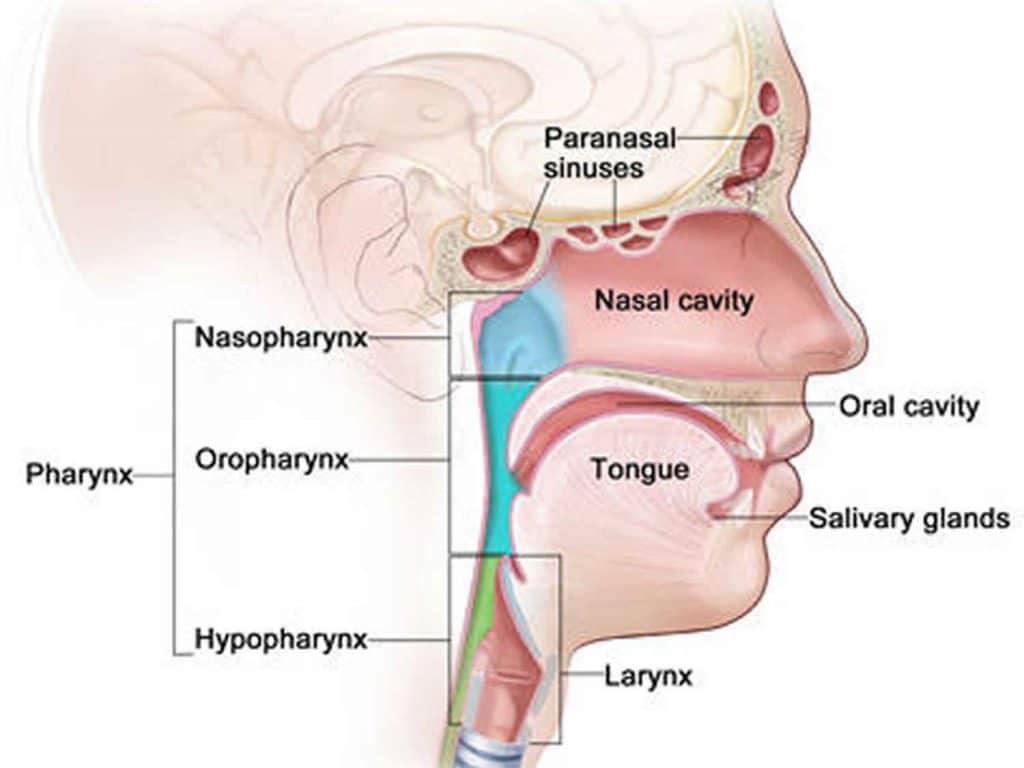Types of Head and Neck Cancer
Throat Cancer
On this page
Head&Neck Cancer Types
Cancer Description
The throat (pharynx) includes 3 different parts that can be affected by cancer:
- Upper throat (Nasopharynx) – the part of the throat that connects the back of the nose to the back of the mouth.
- It’s one of the rarest types of head and neck cancer in the UK.
- Risk factors include:
- Southern Chinese or if you have an affected relative.
- Previous infection with the Epstein Barr virus, a common virus that causes glandular fever.
- People aged 40 years and over, and
- Men are about three times more likely than women to get nasopharyngeal cancer.

- Middle throat (Oropharynx) – the middle part of the throat behind the mouth. This area includes the base of tongue (the part you cannot see), the soft part of the roof of the mouth (soft palate), the tonsils and the side walls of the throat to the tip of the voice box.
- This is becoming the most common site of Head and Neck cancers due to the strong link with the human papilloma virus (HPV).
- Lower throat (Hypopharynx) – the part of the throat connecting the oropharynx to the food pipe and the wind pipe. It is the lower part of the throat that surrounds the larynx and is also called the gullet.
Symptoms of throat cancer
The most common symptoms of cancer in the middle and lower throat include a lump in the neck (often painless), a persistent sore throat and/or earache and difficulty swallowing. Other signs include;
- Unexplained weight loss
- Voice changes/hoarseness
- Persistent cough
Common Treatment Approaches
The treatment for throat cancer typically involves a combination of treatment methods, and the exact prognosis depends heavily on the stage at diagnosis and whether the cancer is HPV-positive or negative. The biopsy will provide the necessary information on whether the tumour is HPV-positive or negative. Your consultant will describe your specific treatment and prognosis. The information below is for illustration purposes only;
- Radiotherapy. Often the primary treatment, usually 30 to 35 doses are given over 5 days a week for 6-7 weeks. The treatment may be combined with chemotherapy (chemoradiation). Modern techniques like IMRT (Intensity-Modulated Radiation Therapy) help minimize side effects.
- Chemotherapy. Usually combined with radiotherapy and may be given before, during, or after radiotherapy. Often the secondary treatment, usually 3 cycles of chemo are given at the beginning, middle and end of the radiotherapy calendar. Common drugs used include cisplatin, carboplatin, and 5-fluorouracil.
- Surgery. Transoral robotic surgery (TORS) is increasingly commonly used for throat cancer treatment and involves removal of the tumour and affected lymph nodes. It is less invasive than traditional open surgery and leads to better preservation of swallowing function. Surgery may be combined with radiotherapy to give a “safety margin” around the tumour site.
The prognosis for HPV-positive throat cancer is generally better than HPV-negative throat cancer. The 5-year survival rate for HPV-positive throat cancer is 80-90% combined with 50-60% for HPV-negative throat cancer. The latter is often related to smoking/alcohol use and has a higher risk of recurrence. Your consultant will evaluate your overall general health at the point of diagnosis looking at the following aspects; the cancer stage at diagnosis, age and lifestyle.
The consultant will have regular check-ups with you for at least 5 years after treatment. Many patients can return to normal activities, though some may experience lasting effects from treatment, such as dry mouth or changes in swallowing function. See Post Treatment side effects.
Useful Links
Suggested additional sites that may offer helpful information:
Throat cancer tests and next steps in the NHS
Podcasts
This oral health podcast is dedicated to HPV vaccine podcast. People are not having the HPV vaccine, so what impact is that having on mouth cancer incidence rates?
Life After Throat Cancer@TheThroatBloke discusses his cancer journey, from diagnosis with throat cancer to living after treatment.
Patient Stories
Please join our private Facebook Group to get support and advice from fellow patients and carers





